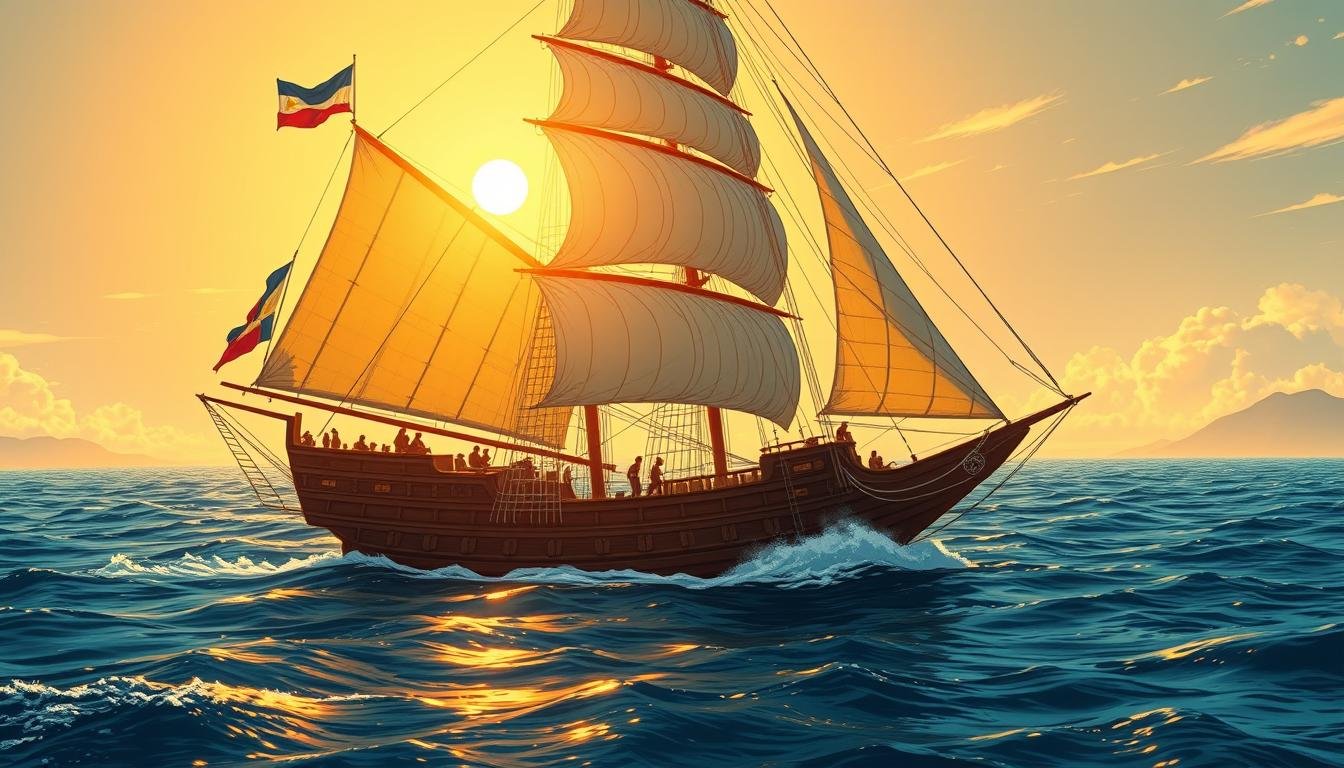Did you know that over 30 ships were lost at sea during the historic Manila-Acapulco route? This maritime path, spanning over 8,000 miles, became a lifeline connecting Asia, the Americas, and Europe for nearly 250 years. It was a journey fraught with danger, yet it shaped the course of global commerce and cultural exchange.
Under Spanish colonial rule, this route became a cornerstone of international trade. Ships carried silver from South America to Manila, where it was exchanged for Asian goods like silk, spices, and porcelain. The galleons that sailed this route were marvels of their time, weighing up to 1,500 tons and braving the unpredictable Pacific Ocean.
This trade not only enriched Spain but also linked distant parts of the world in ways never seen before. The legacy of this historic route continues to influence global connections today.
Key Takeaways
- The Manila-Acapulco route connected Asia, the Americas, and Europe for 250 years.
- Spanish colonial power managed and regulated this vital trade route.
- Galleons carried silver, silk, spices, and porcelain across the Pacific.
- Over 30 ships were lost at sea due to storms and other hazards.
- This trade route significantly influenced global commerce and cultural exchange.
Introduction to the Galleon Trade
In 1565, a groundbreaking maritime route was established, forever changing global commerce. This route, known as the Manila-Acapulco connection, linked the Philippines and Mexico for 250 years. It became a vital artery for goods, ideas, and cultures.
The journey was divided into two main directions. Westward voyages carried supplies like silver and tools to the Philippines. Eastward trips returned with luxury items such as silk, spices, and porcelain from Asia. This dual nature made the route a cornerstone of international exchange.
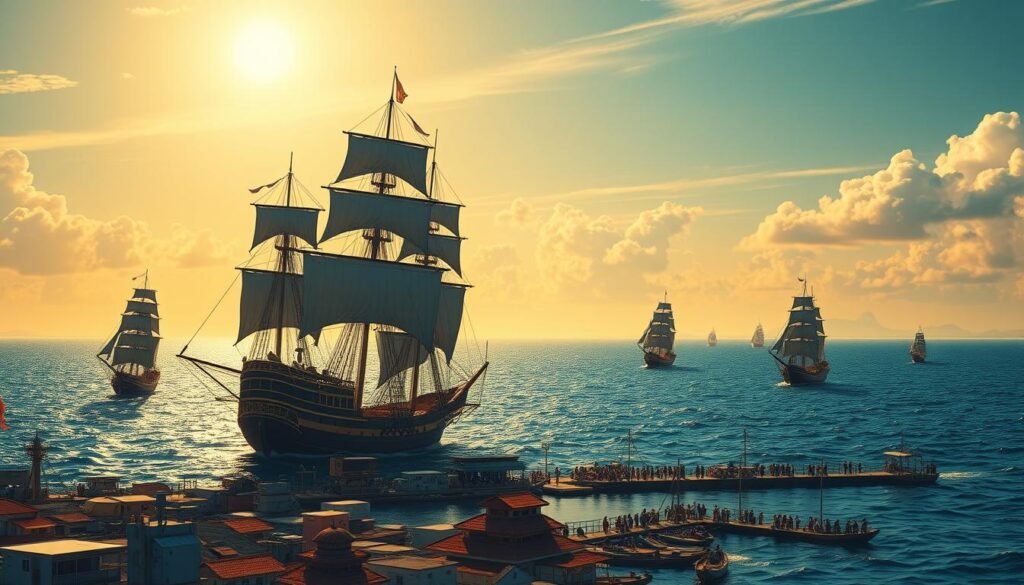
The Philippines and Mexico played crucial roles in this transpacific commerce. The Philippines served as a hub for Asian goods, while Mexico acted as a gateway to the Americas and Europe. Together, they formed a bridge between continents.
The Spanish Crown heavily regulated this trade. They mandated strict controls to ensure profits and security. This oversight shaped the operations and success of the route.
At its core, this trade network combined the wealth of Asia with the silver of the New World. It created a global trading system that influenced economies and cultures worldwide.
Galleon Trade: Historical Foundations and Navigational Breakthroughs
The quest to navigate the vast Pacific Ocean began with Ferdinand Magellan’s daring expedition. In 1521, his crew became the first Europeans to cross the Pacific, opening a new chapter in maritime history. This journey was fraught with challenges, from treacherous storms to dwindling supplies, yet it laid the groundwork for future explorers.
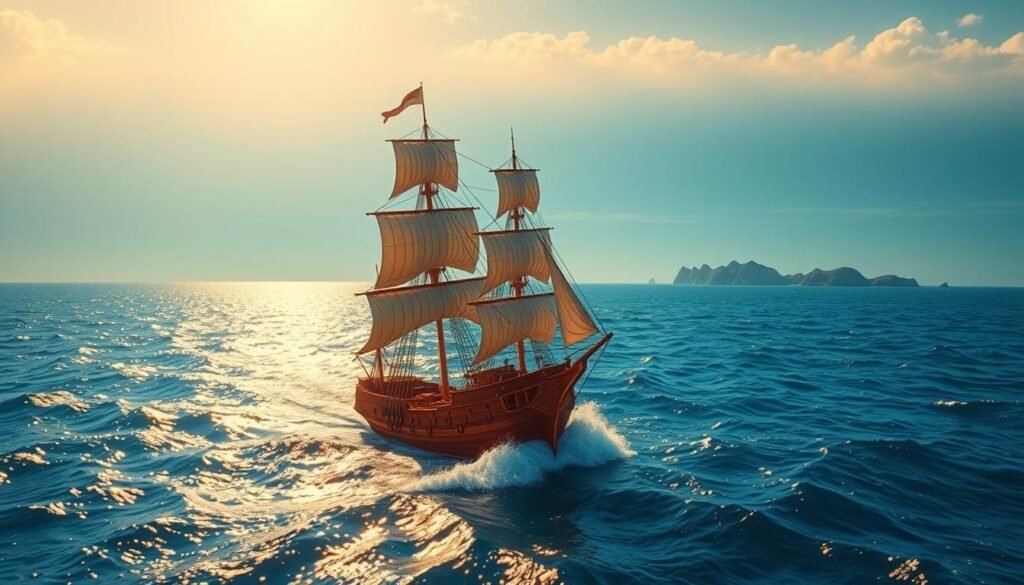
Magellan’s Early Encounters and the Quest for a Pacific Route
Magellan’s voyage was a bold attempt to find a westward route to the Spice Islands. His fleet faced immense hardships, including mutiny and starvation. Despite these obstacles, they successfully reached the Philippines, proving the feasibility of a Pacific crossing. However, Magellan’s death in 1521 left his crew to complete the journey without him.
Subsequent explorers struggled to replicate Magellan’s success. The Pacific remained a formidable barrier, with its vast distances and unpredictable weather. It wasn’t until decades later that a reliable return route was discovered, thanks to the ingenuity of Andrés de Urdaneta.
Andrés de Urdaneta’s Pioneering Return Route
In 1565, Urdaneta, a seasoned navigator, achieved a groundbreaking feat. He discovered the tornaviaje, or return route, from the Philippines to Mexico. This path utilized the Kuroshio Current and prevailing winds, enabling safer and faster voyages. Urdaneta’s discovery transformed transpacific navigation, making the Manila-Acapulco connection viable.
This navigational breakthrough was a turning point in maritime history. It allowed for the establishment of a sustained trade network across the Pacific, linking Asia, the Americas, and Europe. The innovations of Magellan and Urdaneta shaped the era of global exploration and commerce.
Economic Impact: Silver, Spices, and Global Commerce
Silver from the Americas became the backbone of a thriving international economy. It flowed into Asia, where it was exchanged for luxury goods like silk, spices, and porcelain. This exchange created a global network that reshaped economies across continents.
The Manila-Acapulco route was a hub for arbitrage. Silver was cheaper in the Americas but highly valued in Asia. This price difference fueled immense profit opportunities. Merchants could buy silver in Mexico and sell it in Manila for a significant markup.
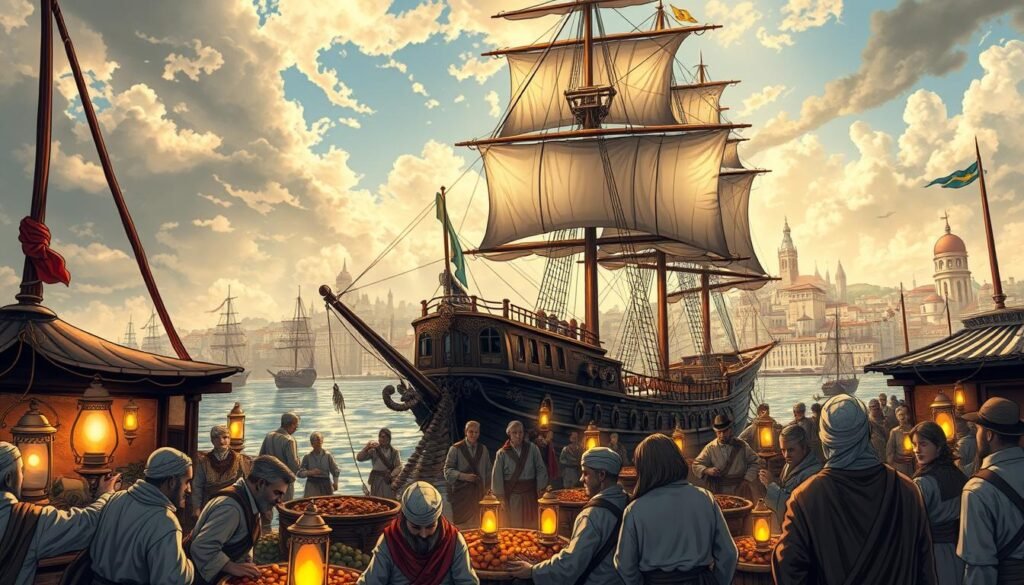
The cargo transported on these voyages was diverse. Ships carried spices like cinnamon and pepper, silk from China, and fine porcelain. Tobacco also became a valuable commodity, traded alongside precious stones and ivory. These goods were highly sought after in Europe and the Americas.
New Spain, particularly Mexico, benefited greatly from this trade. The influx of Asian luxury goods boosted local economies. At the same time, the export of silver strengthened Spain’s global influence. This economic ripple effect extended far beyond the Pacific.
“The exchange of silver and luxury goods was not just about commerce—it was a cultural bridge.”
Contraband and smuggling played a significant role. Official trade was heavily regulated, but illegal activities supplemented profits. Smugglers often bypassed taxes, bringing additional wealth to merchants and traders.
This trade network also had global implications. The demand for silver in China influenced its economy. The influx of New World silver contributed to economic shifts in Asia, including the decline of the Ming dynasty.
- Silver from the Americas fueled Asian markets.
- Arbitrage opportunities created immense wealth.
- Cargo included spices, silk, porcelain, and tobacco.
- New Spain’s economy thrived on this exchange.
- Contraband supplemented official trade profits.
The Manila-Acapulco connection was more than a trade route—it was a catalyst for global economic change. Its legacy continues to influence modern commerce and cultural exchange.
Constructing the Manila Galleons: Filipino Shipbuilding Marvels
The shipyards of Cavite became the heart of maritime innovation in the Philippines. These bustling ports were where some of the largest ships of their time were built. Using native hardwoods like Philippine teak, local craftsmen created vessels that could withstand the harsh conditions of the Pacific.
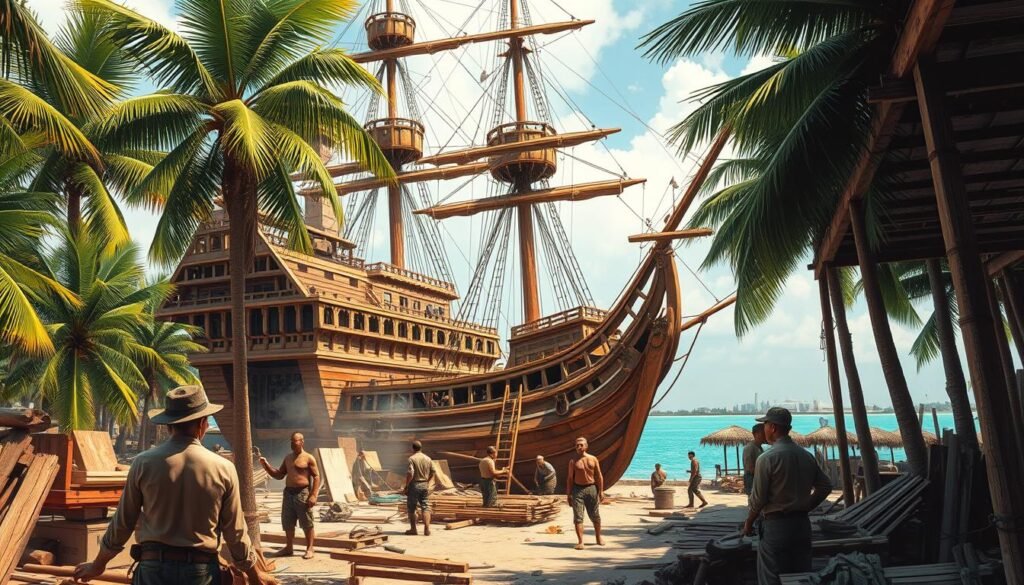
Indigenous techniques played a crucial role in the construction process. Filipino shipbuilders combined traditional methods with new innovations to meet the demands of Spanish colonial needs. This blend of skills resulted in ships that were both durable and efficient.
Cavite shipyards employed thousands of carpenters, many of whom were locals. Their expertise was essential in producing vessels for the transpacific route. Despite challenges like overwork and unpaid labor, these craftsmen left a lasting legacy in maritime history.
The Spanish influence on ship design was significant. They required ships that could carry large cargoes and navigate long distances. Filipino shipbuilders adapted their methods to meet these needs, creating vessels that became an essential part of global commerce.
| Key Elements | Details |
|---|---|
| Materials | Philippine teak and native hardwoods |
| Techniques | Indigenous methods combined with Spanish innovations |
| Location | Cavite shipyards, a central port for construction |
| Impact | Essential part of global maritime history |
These shipbuilding marvels were more than just vessels. They were symbols of the ingenuity and resilience of the Filipino people. Their contributions to maritime history continue to be celebrated today.
Life on Board: Crew, Challenges, and Daily Experiences
Life aboard the ships was a test of endurance, with crews facing unimaginable hardships. The sea was both their workplace and their greatest adversary. Every day brought new challenges, from storms to disease, making survival a constant struggle.
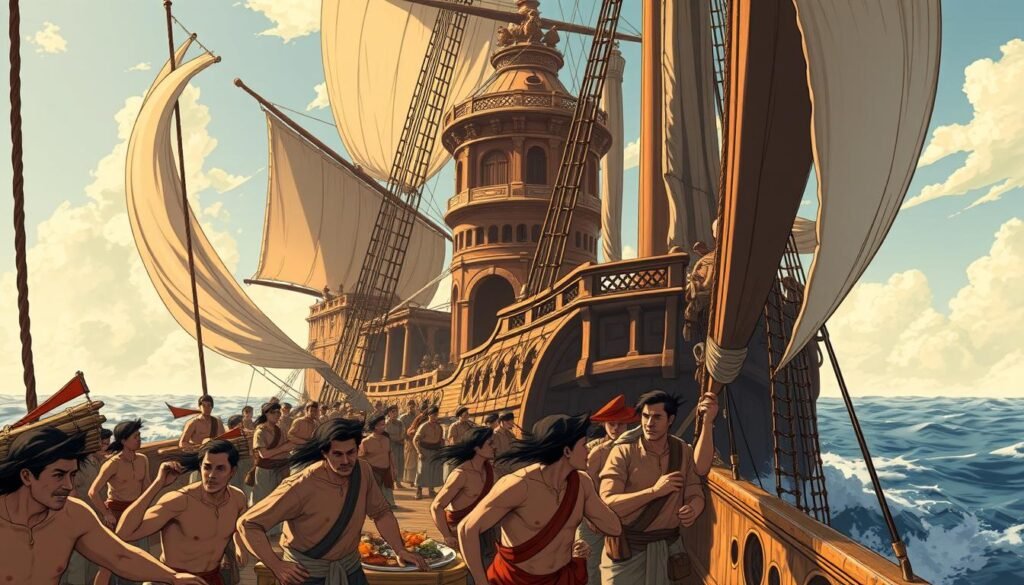
The crew was a diverse mix of individuals, including many Filipino sailors. These men brought invaluable skills and knowledge to the voyages. However, not everyone on board was there by choice. Many were slaves or underprivileged persons forced into service. Their stories highlight the darker side of maritime history.
Daily life was grueling. Food shortages were common, and disease spread quickly in the cramped quarters. Sailors often worked long hours, battling exhaustion and the elements. Despite these conditions, the crew showed remarkable resilience. Their endurance was a testament to the human spirit.
“The hardships faced by these sailors were unimaginable, yet their courage kept the ships afloat.”
Involuntary recruitment was a harsh reality. Many slaves and poor persons were forced into service, with no hope of escape. Their contributions were vital, yet often overlooked. This practice underscored the inequalities of the time.
The heroism of the crew cannot be overstated. They braved the sea, facing storms, mutinies, and starvation. Their sacrifices were a cornerstone of early global commerce. Life on board was more than a journey—it was a symbol of the broader struggles of the era.
For more insights into the challenges of life at sea, explore this detailed resource. Additionally, learn about the social dynamics aboard ships in this study.
Navigating Trade Routes: From Manila to Acapulco
Navigating the vast Pacific required skill, strategy, and a deep understanding of the elements. The trade route from Manila to Acapulco was a marvel of its time, connecting distant lands through a combination of natural forces and human ingenuity.
The tornaviaje, or return route, was a groundbreaking discovery. Andrés de Urdaneta found a way to harness the Kuroshio Current and prevailing winds, making the journey safer and faster. This innovation transformed the trade route, ensuring its viability for centuries.
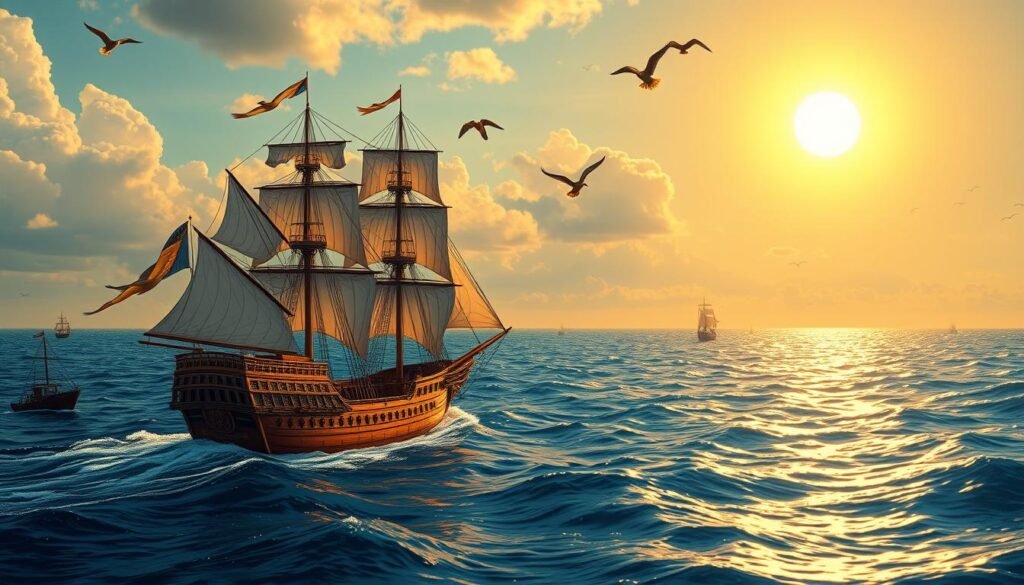
Trade winds and ocean currents were essential to the voyage. Sailors relied on these natural forces to optimize their path across the Pacific. By understanding the patterns of the wind and sea, they could reduce travel time and avoid dangerous storms.
Coastal stopovers played a vital role in the journey. Ships would dock at key points along the coast to resupply and rest. These stops were crucial for the crew’s survival and the success of the voyage.
Once goods reached Acapulco, they were transported overland to Veracruz. Mule trains carried the cargo across the land, linking the Pacific to the Atlantic. This overland system was a critical part of the global trade network.
Navigational strategies balanced safety and efficiency. Sailors used a mix of scientific observation and trial and error to chart their course. This approach ensured that the ship could navigate the unpredictable waters of the Pacific.
“The success of these voyages was a testament to the skill and resilience of the sailors who braved the unknown.”
The idea behind these routes was as much about exploration as it was about commerce. Each journey added to the collective knowledge of the seas, paving the way for future explorers. The legacy of these navigational feats continues to inspire maritime innovation today.
For more details on the history of the Manila-Acapulco connection, visit this resource.
Cultural Exchange and Mutual Influence
The Manila-Acapulco connection wasn’t just about goods—it was a bridge for cultures. This historic route fostered rich exchanges between Asia, the Americas, and Europe. It brought people together, blending traditions and shaping societies in lasting ways.
Chinese and Philippine influences were deeply felt along the route. From China, silk, porcelain, and spices flowed into the Americas, while Filipino craftsmanship and artistry left their mark. These elements enriched local cultures, creating a unique fusion of styles and practices.
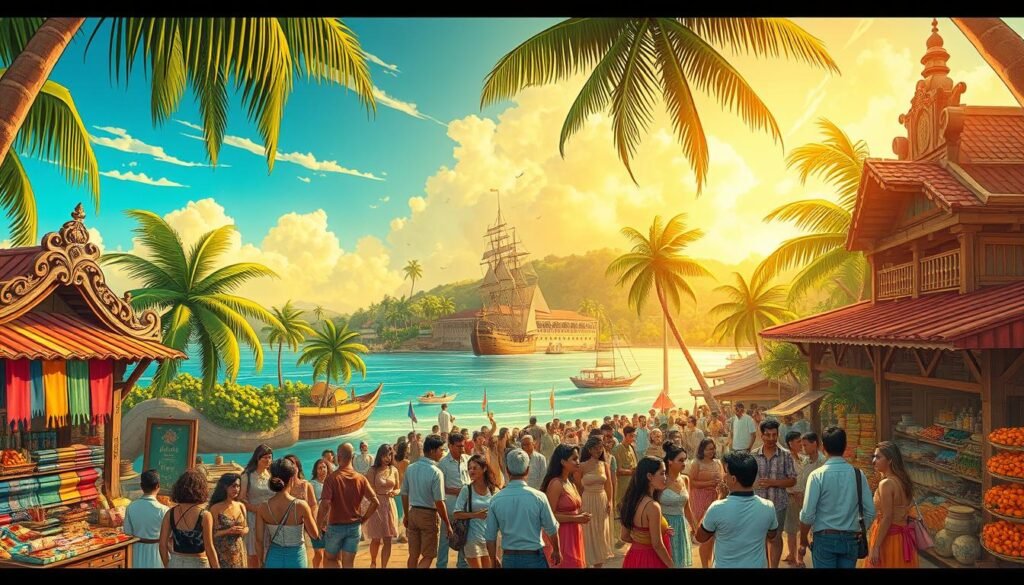
Guam and its surrounding islands played a pivotal role as cultural crossroads. The CHamoru people of Guam absorbed and adapted foreign influences, creating a vibrant mix of traditions. This blending of cultures made the islands a hub of diversity and innovation.
Language, food, art, and customs were transformed through these exchanges. Words from China and the Philippine languages entered local vocabularies. Dishes like tamales and adobo reflect this cultural fusion. Artisans combined techniques, producing works that showcased the best of multiple traditions.
“The exchange of ideas and traditions was as valuable as the trade in goods.”
Spaniards played a dual role in this cultural exchange. They transmitted European values while absorbing Asian and American influences. This reciprocal exchange enriched all parties involved, creating a legacy that endures today.
For a deeper dive into these cultural connections, explore this detailed resource on the Manila Galleon’s impact on global history.
The Decline of the Manila Galleon Era
By the late 18th century, the once-thriving maritime route began to face insurmountable challenges. Political and economic shifts, including the Mexican independence movement, disrupted the established system. These changes marked the beginning of the end for this historic connection.
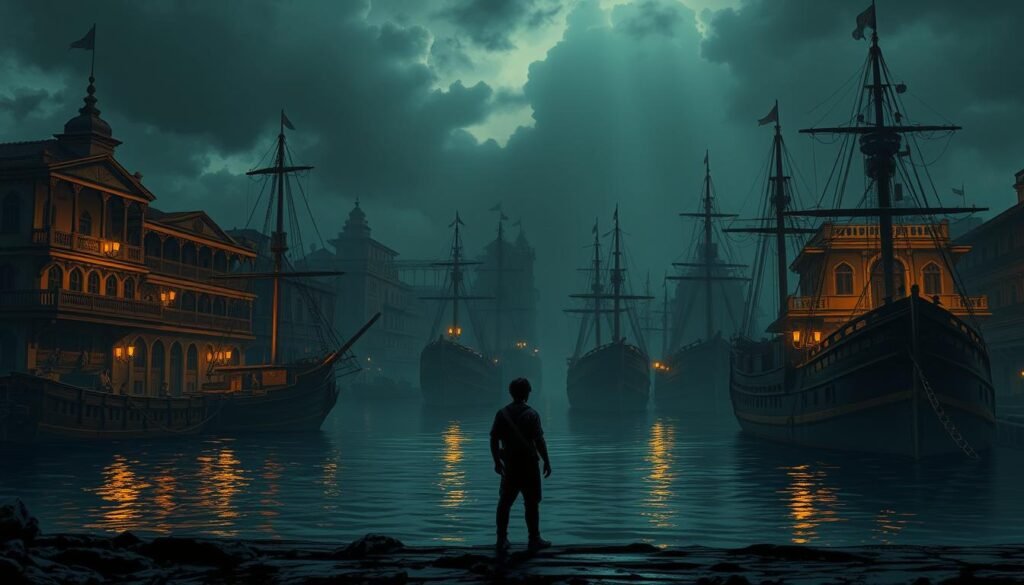
The Bourbon Reforms in the 18th century aimed to modernize Spain’s colonial administration. However, these changes often weakened the control over the Manila-Acapulco route. As new shipping technologies emerged, the traditional galleons became obsolete.
In the early 19th century, the rise of steam-powered vessels revolutionized maritime travel. These modern ships were faster and more efficient, rendering the old system unsustainable. The transition marked a significant turning point in global commerce.
“The decline of the Manila Galleon era was not just an end—it was the beginning of a new chapter in maritime history.”
The loss of Spanish control in the Americas further accelerated the decline. The Mexican War of Independence (1810–1821) disrupted the flow of silver, a key component of the trade. Without this vital resource, the route lost its economic foundation.
By the mid-19th century, the Manila Galleon era had come to a close. The reorganization of trade routes and the rise of new technologies reshaped global maritime commerce. This period marked the end of an era that had connected continents for over 250 years.
For more insights into the economic shifts following this decline, explore the impact of the opium trade in China during this transformative period.
Conclusion
Over time, the historic connection between Manila and Acapulco reshaped the world in profound ways. For 250 years, this route linked continents, economies, and cultures in a way never seen before. It wasn’t just about gold or goods—it was a bridge for ideas and innovation.
Breakthroughs in navigation and shipbuilding emerged from this era, paving the way for modern maritime travel. The exchange of gold, spices, and cultural traditions left a lasting legacy. These interactions laid the foundation for today’s global trade systems.
From the Mexican silver mines to the bustling ports of Asia, this route connected distant lands. It transformed societies and economies, proving the power of human ingenuity. The lessons from this era continue to inspire our understanding of global connections.
For more insights into this transformative period, explore the legacy of the Manila-Acapulco connection.
FAQ
What was the primary purpose of the Manila-Acapulco route?
The route connected Asia and the Americas, enabling the exchange of goods like silver, spices, and silk between the Philippines, Mexico, and Spain.
Who discovered the return route across the Pacific?
Andrés de Urdaneta, a Spanish navigator, found the reliable return path from the Philippines to Mexico in 1565, revolutionizing trans-Pacific travel.
What role did Filipino shipbuilders play in the Manila-Acapulco trade?
Filipino craftsmen were essential in constructing the sturdy galleons that sailed the Pacific, showcasing their advanced shipbuilding skills.
How did the Manila-Acapulco trade impact global commerce?
It facilitated the flow of silver from Mexico to Asia and spices from the East to Europe, shaping early global trade networks.
What challenges did crews face on the Manila galleons?
Sailors endured harsh conditions, including storms, disease, and limited supplies, during the long and perilous voyages across the Pacific.
What led to the decline of the Manila-Acapulco trade?
Factors like political changes, competition from other trade routes, and the rise of new economic systems contributed to its eventual decline.
How did the Manila-Acapulco trade influence cultural exchange?
It fostered the blending of Filipino, Mexican, and Spanish cultures, impacting art, cuisine, and traditions in both regions.
What goods were commonly transported on the Manila galleons?
Ships carried silver, silk, porcelain, and spices from Asia, while returning with tobacco, chocolate, and other New World products.
Source Links
- MANILA GALLEON TRADE – War History
- The Manila Galleons – Ocean Navigator
- Manila Galleon Trade Route-La Nao de China: A Legacy in the Marianas – Guampedia
- Manila Galleon
- Manila Galleon: From Asia to the Americas
- The Remains of a Manila Galleon Compass: 16th-Century Nautical Material Culture
- Philip II Orders the Journey of the First Manila Galleon – San Diego History Center | San Diego, CA | Our City, Our Story
- Manila galleon
- The Manila-Acapulco Galleon Trade
- explorations by early navigators, descriptions of the islands and their peoples, their history and records of the catholic missions, as related in contemporaneous books and manuscripts, showing the political, economic, commercial and religious conditions of those islands from their earliest
- explorations by early navigators, descriptions of the islands and their peoples, their history and records of the catholic missions, as related in contemporaneous books and manuscripts, showing the political, economic, commercial and religious conditions of those islands from their earliest
- Galleon trade coming to life in 3D
- Why the Magellan Expedition Was So Treacherous | HISTORY
- Manila: From Galleons to the Belt and Road
- The Manila Galleon, a Spanish trade route that connected 3 continents
- The Manila Galleons that oceaneered for plague and profit | Aeon Essays
- MANILA GALLEON
- Manila Galleon Trade Textiles: Cross-Cultural Influences on New
World Dress - The Manila Galleon – The map as History
- Conclusion – Forced Migration in the Spanish Pacific World
- How did the Manila Galleon trade affect East Asia? | TutorChase

